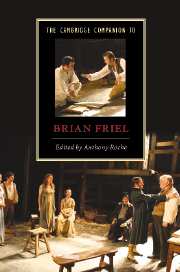Book contents
- Frontmatter
- 1 Introduction
- 2 The early plays
- 3 Surviving the 1960s: three plays by Brian Friel 1968-1971
- 4 Friel and the Northern Ireland “Troubles” play
- 5 Family affairs: Friel’s plays of the late 1970s
- 6 Five ways of looking at Faith Healer
- 7 Translations, the Field Day debate and the re-imagining of Irish identity
- 8 Dancing at Lughnasaand the unfinished revolution
- 9 The late plays
- 10 Friel’s Irish Russia
- 11 Friel and performance history
- 12 Friel’s dramaturgy: the visual dimension
- 13 Performativity, unruly bodies and gender in Brian Friel’s drama
- 14 Brian Friel as postcolonial playwright
- Bibliography
- Index
6 - Five ways of looking at Faith Healer
Published online by Cambridge University Press: 28 January 2007
- Frontmatter
- 1 Introduction
- 2 The early plays
- 3 Surviving the 1960s: three plays by Brian Friel 1968-1971
- 4 Friel and the Northern Ireland “Troubles” play
- 5 Family affairs: Friel’s plays of the late 1970s
- 6 Five ways of looking at Faith Healer
- 7 Translations, the Field Day debate and the re-imagining of Irish identity
- 8 Dancing at Lughnasaand the unfinished revolution
- 9 The late plays
- 10 Friel’s Irish Russia
- 11 Friel and performance history
- 12 Friel’s dramaturgy: the visual dimension
- 13 Performativity, unruly bodies and gender in Brian Friel’s drama
- 14 Brian Friel as postcolonial playwright
- Bibliography
- Index
Summary
One of the measures of a great work of the imagination is not just its openness to several different interpretations, but the unexplained residuum that it leaves after any and every interpretation. Faith Healer is a dramatic enactment of the fictions of memory; it is a portrait of the artist as charlatan/miracle worker; it is a parable of Irish exile and return; it is a secular theatrical recreation of religious rites: all true, or at least valid, illuminating readings. Yet watch or read the play once again, and something within the experience continues to elude any of these constructions of its meaning. The formal closure of Frank Hardy's final monologue, as he moves to leave the stage and face the death that has already taken place, does not yield itself to such explanation. Instead it enforces belief in what can be acted out but not fully understood.
Contested narratives
One story, three storytellers, each with their own way of recalling the past they have shared. On the surface Faith Healer looks like the sort of fiction where different narratives of the same events reveal the unreliability of the narrators: Faulkner’s The Sound and the Fury has been suggested as one model; Kurosawa’s film Rashomon, another. Certainly, the four monologues that make up the play – first by Frank the traveling faith healer, then by his partner Grace, followed by his manager Teddy, and then by Frank again – do highlight the divergences between their accounts. There are significant discrepancies in the retelling of some of the principal events of their life together: the time when Grace and Frank were living in a converted byre in Norfolk, the miraculous cure of ten disabled people in Llanbethian in Wales, the baby stillborn in Kinlochbervie, Scotland, and the terminal encounter with the wedding guests in Ballybeg, County Donegal. The play puts up to an audience the puzzle of who is telling the truth, or what the individual distortions of the story may reveal about the characters.
- Type
- Chapter
- Information
- The Cambridge Companion to Brian Friel , pp. 53 - 65Publisher: Cambridge University PressPrint publication year: 2006



